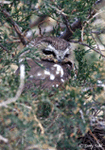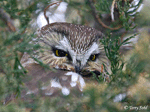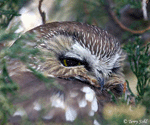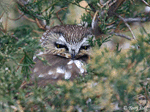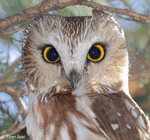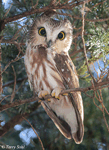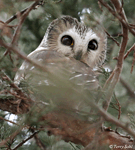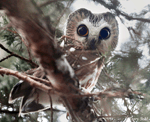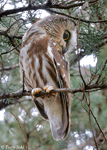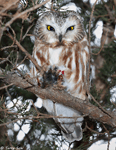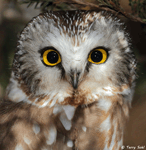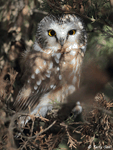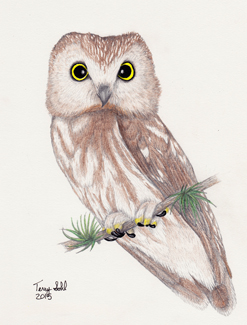Northern Saw-whet Owl
Aegolius acadicus
| Length: 8 inches | Wingspan: 19 inches | Seasonality: Winter / All Seasons |
| ID Keys: Lack of ear tufts, small size, pale facial disks, brownish spotted upperparts | ||
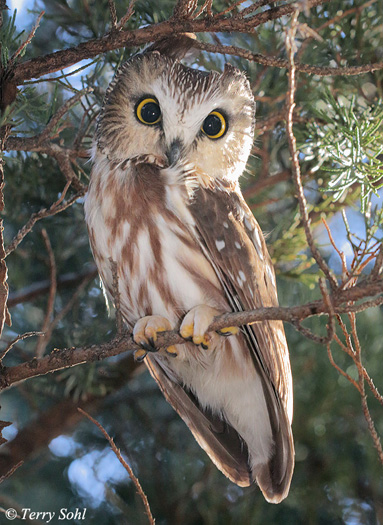 Northern
Saw-whet Owls are a very small owl of conifer forests. They are named for
their loud,
persistent night-time song during breeding season, which may carry on for hours
at a time. They are often extremely tame, allowing for very close
approaches. This behavior can also make them somewhat difficult to locate,
as they likely won't move or flush upon approach. The difficulty in seeing
Northern Saw-whet Owls is also complicated by their choice of habitat, as
they're typically found in dense conifer stands on their daylight roosts.
Northern
Saw-whet Owls are a very small owl of conifer forests. They are named for
their loud,
persistent night-time song during breeding season, which may carry on for hours
at a time. They are often extremely tame, allowing for very close
approaches. This behavior can also make them somewhat difficult to locate,
as they likely won't move or flush upon approach. The difficulty in seeing
Northern Saw-whet Owls is also complicated by their choice of habitat, as
they're typically found in dense conifer stands on their daylight roosts.
Habitat: Prefers coniferous forest during summer breeding season. May winter in any forested habitat, although more commonly in conifer groves. In South Dakota, I've had the best luck finding their roosts in stands of dense, relatively young eastern red cedar trees. The young trees often are spaced quite close together and have denser foliage, providing more cover for Northern Saw-whet Owls than older conifer trees.
Diet: Mostly small mammals, occasionally small birds and large insects. Given their small size, even a mouse or a mole is sometimes too large of a prey item for a Northern Saw-whet Owl to consume at one sitting. They will often consume half of their prey, caching the other half the crook of a tree branch for later consumption. Given the cold environments they're often found in, those cached items often freeze solid, leading to Northern Saw-whet Owls "incubating" cached prey to thaw it prior to consumption (see photos below).
Behavior: Almost completely nocturnal, hunting only at night. Capable of finding prey both by sight and by sound, they primarily observe from a perch, swooping down to capture prey as its located.
Nesting: May and June. The nest of a Northern Saw-whet Owl is placed in a cavity, historically in a tree cavity such as an old woodpecker hole, but they will also use nest boxes of the appropriate size. No new material is added to the nesting cavity, although they will use existing debris or nesting material from the species that previously occupied the nest. The female lays 4 to 7 eggs, with the female alone incubating them. The male delivers food during the roughly 4-week incubation period. The young leave the nest after about 4 to 5 weeks, but the parents may continue to defend and feed the young for up to another 2 months after fledging.
Song: Long series of single toots. They primarily vocalize during the breeding season. Click here to hear the advertising song of a male. Click here to hear an alarm call, more of a series of moaning calls. (Both audio files by Lance A.M. Benner, from Los Angeles County in California).
Migration: Semi-permanent resident in higher elevations of North America. Some move south and to lower elevations in winter, but movements are irregular and somewhat unpredictable. In winter in South Dakota, they may be present in good numbers one year, and almost completely absent in subsequent years.
Interactive eBird Map: Click here to access an interactive eBird Map of Northern Sawwhet Owl sightings
Similar Species: Boreal Owl, Eastern Screech Owl
Conservation Status: Widespread and fairly common, although some local declines have been noted, primarily due to habitat loss. However, the IUCN considers the Northern Saw-whet Owl to be a species of "Least Concern".
Birdhouses: Will use appropriately sized nest boxes. Northern Saw-whet Owls are commonly found as nesting birds in nest boxes placed for them in the far western part of the state.
South Dakota "Hotspot": Birders in the Pierre area have found significant numbers of Northern Saw-whet Owls overwintering in cedar/juniper trees near the Missouri River and Lake Oahe near Pierre. They may be more widespread in South Dakota in winter though. Recent searches of similar cedar thickets in the southeastern part of the state have also found several Saw-whet owls. I have found several in the cedar stands at Newton Hills State Park and elsewhere in the southeastern part of the state.. Given the dense habitat they prefer for daytime roosts and the difficulty in visually locating one, they may be around in significant numbers.
Further Information: 1) USGS Patuxent Bird Identification InfoCenter, Northern Saw-Whet Owl
2) Audubon's Field Guide - Northern Saw-whet Owl
3) BirdWeb - Northern Saw-whet Owl
Photo Information: January 27th, 2015 - Lincoln County, South Dakota - Terry Sohl
Additional Photos: Click on the image chips or text links below for additional, higher-resolution Northern Saw-whet Owl photos.
| Click on the map below for a higher-resolution view |
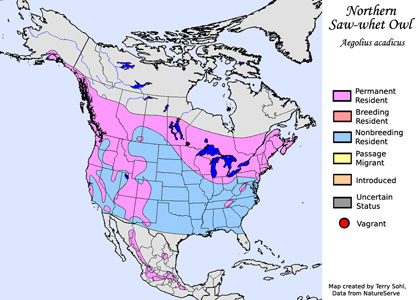 |
| South Dakota Status: Present at all seasons in the Black Hills, occasionally in other pine forest of the western part of the state. Casual to uncommon winter resident in the rest of the state. |
Additional Northern Saw-whet Owl Photos
Click for a higher-resolution version of these photos

